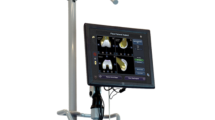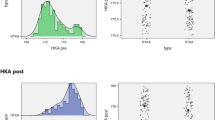Abstract
Introduction
Total knee arthroplasty (TKA) is the gold standard for treatment of end-stage osteoarthritis. Previous studies have shown that successful outcomes following TKA depend on accurate implant alignment and soft tissue balancing. Robotic-assisted TKA have demonstrated improved accuracy in component placement and have been associated with better outcomes and patient satisfaction. This study aims to report on the execution accuracy of two generations of handheld robotic-assisted surgical systems.
Methods
This was a retrospective analysis of TKA procedures with two sequential generations of the same handheld robotic-assisted surgical system. Intra-operative data captured included pre-operative limb deformity, limb axes, range of motion, kinematic balance, and the resulting plan for component placement in three-dimensional space. Patients were stratified based on their preoperative coronal lower limb mechanical alignment (> 3° varus, < 3° varus, < 3° valgus, and ≥ 3° valgus). Measurements of component placement (overall lower limb alignment, medial and lateral flexion gaps, and tibial and femoral resection depths) were assessed using descriptive statistics.
Results
A total of 435 patients were included and stratified based on preoperative lower limb alignment: 229 with ≥ 3° varus, 78 with varus < 3° and 58 with valgus < 3°, and 70 with valgus > 3°. The mean difference between planned and achieved alignment in the lower limb valgus patients was < 1° across all groups. Mean differences between planned and achieved medial flexion gap was higher in the > 3° subgroup in the varus patient cohort ([< 3°]: 1.15 ± 1.92 vs. [> 3°]: 1.90 ± 2.57); this value was higher in the < 3° subgroup for valgus patients ([< 3°]: 1.34 ± 1.83 vs. [> 3°]: 0.956 ± 1.65). Average resection depth ranged from 9.46 to 10.4 mm in the posterior medial femur, 9.25 to 9.95 mm in the posterior lateral femur, 7.45 to 8.79 mm in the distal medial femur, 8.22 to 9.18 mm in the distal lateral femur, 6.70 to 7.07 mm in the medial tibial condyle and 6.40 to 7.19 mm in the lateral tibial condyle. Non-inferiority testing demonstrated the newer generation is non-inferior to the older generation.
Conclusion
Robotic-assisted knee replacement using handheld image-free systems is able to maintain accuracy of component placement. Further investigation of patient reported outcomes as well as long-term implant longevity are needed.


Similar content being viewed by others
References
Kurtz S, Ong K, Lau E, Mowat F, Halpern M (2007) Projections of primary and revision hip and knee arthroplasty in the United States from 2005 to 2030. J Bone Joint Surg 89(4):780–785. https://doi.org/10.2106/JBJS.F.00222
Golladay GJ et al (2019) Are patients more satisfied with a balanced total knee arthroplasty? J Arthroplasty 34(7):S195–S200. https://doi.org/10.1016/j.arth.2019.03.036
Postler A, Lützner C, Beyer F, Tille E, Lützner J (2018) Analysis of total knee arthroplasty revision causes. BMC Musculoskelet Disord 19(1):55. https://doi.org/10.1186/s12891-018-1977-y
Bollars P, Boeckxstaens A, Mievis J, Kalaai S, Schotanus MGM, Janssen D (2020) Preliminary experience with an image-free handheld robot for total knee arthroplasty: 77 cases compared with a matched control group. Eur J Orthop Surg Traumatol 30(4):723–729. https://doi.org/10.1007/s00590-020-02624-3
Collier MB, Eickmann TH, Sukezaki F, McAuley JP, Engh GA (2006) Patient, implant, and alignment factors associated with revision of medial compartment unicondylar arthroplasty. J Arthroplasty 21(6):108–115. https://doi.org/10.1016/j.arth.2006.04.012
Hernigou P, Deschamps G (2004) Alignment influences wear in the knee after medial unicompartmental arthroplasty. Clin Orthop Relat Res 423:161–165. https://doi.org/10.1097/01.blo.0000128285.90459.12
Cobb J et al (2006) Hands-on robotic unicompartmental knee replacement: a prospective, randomised controlled study of the acrobot system. J Bone Joint Surg 88-B(2):188–197. https://doi.org/10.1302/0301-620X.88B2.17220
Paul HA et al (1992) Development of a surgical robot for cementless total hip arthroplasty. Clin Orthop Relat Res 285:57–66
Decking J, Theis C, Achenbach T, Roth E, Nafe B, Eckardt A (2004) Robotic total knee arthroplasty. The accuracy of CT-based component placement. Acta Orthop Scand 75(5):573–579. https://doi.org/10.1080/00016470410001448
Bautista M, Manrique J, Hozack WJ (2019) Robotics in total knee arthroplasty. J Knee Surg 32(07):600–606. https://doi.org/10.1055/s-0039-1681053
Song E-K, Seon J-K, Yim J-H, Netravali NA, Bargar WL (2013) Robotic-assisted TKA reduces postoperative alignment outliers and improves gap balance compared to conventional TKA. Clin Orthop Relat Res 471(1):118–126. https://doi.org/10.1007/s11999-012-2407-3
Bellemans J, Vandenneucker H, Vanlauwe J (2007) Robot-assisted total knee arthroplasty. Clin Orthop Relat Res 464:111–116. https://doi.org/10.1097/BLO.0b013e318126c0c0
Lotke PA, Ecker ML (1977) Influence of positioning of prosthesis in total knee replacement. J Bone Joint Surg Am 59(1):77–79
Ritter MA, Faris PM, Keating EM, Meding JB (1994) Postoperative alignment of total knee replacement. Its effect on survival. Clin Orthop Relat Res 299:153–156
Jeffery R, Morris R, Denham R (1991) “Coronal alignment after total knee replacement. J Bone Joint Surg 73-B(5):709–714. https://doi.org/10.1302/0301-620X.73B5.1894655
Bargren JH, Blaha JD, Freeman MA (1983) Alignment in total knee arthroplasty. Correlated biomechanical and clinical observations. Clin Orthop Relat Res 173:178–183
Mason JB, Fehring TK, Estok R, Banel D, Fahrbach K (2007) Meta-analysis of alignment outcomes in computer-assisted total knee arthroplasty surgery. J Arthroplasty 22(8):1097–1106. https://doi.org/10.1016/j.arth.2007.08.001
Hetaimish BM, Khan MM, Simunovic N, Al-Harbi HH, Bhandari M, Zalzal PK (2012) Meta-analysis of navigation vs conventional total knee arthroplasty. J Arthroplasty 27(6):1177–1182. https://doi.org/10.1016/j.arth.2011.12.028
Ponzio DY, Lonner JH (2016) Robotic technology produces more conservative tibial resection than conventional techniques in UKA. Am J Orthop 45(7):E465–E468
Funding
The authors did not receive support from any organization for the submitted work.
Author information
Authors and Affiliations
Corresponding author
Ethics declarations
Conflict of interest
Financial interests: Chelsea S. Sicat, MSc has no financial interests to disclose. Dr. James C. Chow, MD has the following financial interests to disclose: (a) Axolotl Biologix: Stock or stock Options. (b) Microport Orthopedics: Paid consultant; Paid presenter or speaker. (c) Microport Orthopedics, Inc.: IP royalties; Research support. (d) Orthosensor, Inc.: Paid consultant; Paid presenter or speaker; Research support. (e) Pfizer: Stock or stock Options. (f) Smith & Nephew: IP royalties; Paid consultant; Paid presenter or speaker; Research support. (g) Stryker: Stock or stock Options. (h) Vomaris Innovations: Research support. (i) Vomaris Innovations, Inc.: Paid consultant; Stock or stock Options. Dr. Bertrand Kaper, MD has received research support from Smith & Nephew and is a paid consultant for Smith & Nephew. Riddhit Mitra, MSc receives a salary from Smith & Nephew where he is Director of Product Management, Robotics. Dr. Jing Xie, PhD receives a salary from Smith & Nephew where she is Senior Vice President of Cliincal & Medical Affairs. She has stocks in Smith & Nephew, Medtronic, and Zimmer. Dr. Ran Schwarzkopf, MD MSc has the following financial interests to disclose: (a) Gauss surgical: Stock or stock Options. (b) Intellijoint: Paid consultant; Stock or stock Options. (c) PSI: Stock or stock Options. (d) Smith & Nephew: IP royalties; Paid consultant; Research support. Non-financial interests: Chelsea S. Sicat, MSc, Dr. Bertrand Kaper, MD, Riddhit Mitra, MSc, and Dr. Jing Xie, PhD have no non-financial interests to disclose. Dr. James C. Chow, MD serves as a board/committee member for Chow Research Foundation. Dr. Ran Schwarzkopf, MD MSc serves as a board/committee member for the American Academy of Orthopedic Surgeons (AAOS) and American Association of Hip and Knee Surgeons (AAHKS); he is also on the editorial board for Arthroplasty Today and Journal of Arthroplasty.
Ethical approval
Ethical approval was waived in light of the retrospective nature of the study.
Informed consent
Informed consent was not required for this study as only images without identifying data were used.
Additional information
Publisher's Note
Springer Nature remains neutral with regard to jurisdictional claims in published maps and institutional affiliations.
Rights and permissions
About this article
Cite this article
Sicat, C.S., Chow, J.C., Kaper, B. et al. Component placement accuracy in two generations of handheld robotics-assisted knee arthroplasty. Arch Orthop Trauma Surg 141, 2059–2067 (2021). https://doi.org/10.1007/s00402-021-04040-6
Received:
Accepted:
Published:
Issue Date:
DOI: https://doi.org/10.1007/s00402-021-04040-6




